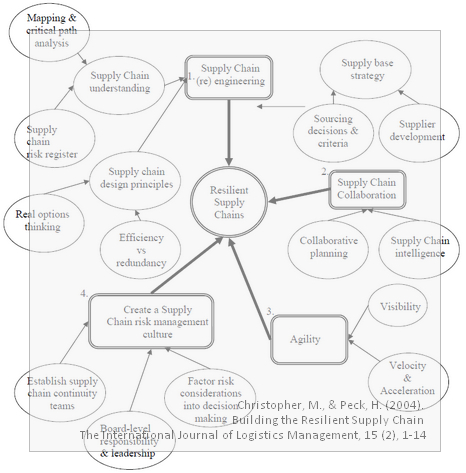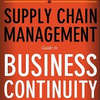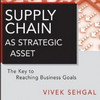 Following up last weeks post on a 2003 UK report on supply chain resilience, here is another “spin-off ” from the supply chain research done at Cranfield University: Building the resilient supply chain, written by Martin Christopher and Helen Peck in 2004. Since its inception this article has formed the bedrock for practically every literature review on supply chain resilience. Frankly, if you are investigating how to make supply chains more resilient, and if you forget to mention this article in your literature review, then I would say that obviously, you have absolutely no clue about supply chains or resilience.
Following up last weeks post on a 2003 UK report on supply chain resilience, here is another “spin-off ” from the supply chain research done at Cranfield University: Building the resilient supply chain, written by Martin Christopher and Helen Peck in 2004. Since its inception this article has formed the bedrock for practically every literature review on supply chain resilience. Frankly, if you are investigating how to make supply chains more resilient, and if you forget to mention this article in your literature review, then I would say that obviously, you have absolutely no clue about supply chains or resilience.
Complicated?
A very interesting figure from the article shows the individual steps and impacts leading up to increased resilience in supply chains:

The basic idea reflects the steps mentioned in the supply chain resilience report that I reviewed last week:
- Re-engineer your supply chain to address supply chain risk
- Engage in supply chain collaboration
- Ensure your supply chain agility
- Nurture a supply chain risk management culture
Re-engineer your supply chain
Conventionally supply chains have often been designed to optimise for cost and/or customer service, rarely was resilience the ‘objective function’ for the optimisation process, but supply chains can be re-engineered to address risk and resilience:
- Supply chain understanding
- Map and analyze critical paths
- Establish a supply chain risk register
- Supply chain design principles
- Real options
- Efficiency versus redundancy
- Supply base strategy
- Supplier development
- Sourcing decisions and criteria
Engage in supply chain collaboration
It will be apparent that since supply chain vulnerability is by definition a networkwide concept, the management of risk has to be network-wide too. A high level of collaborative working across supply chains can significantly help mitigate risk.
- Supply chain collaboration
- Share information on operations and limitations
- Supply chain intelligence
- Exchange of information on trends and strategies
Ensure your supply chain agility
Supply chain agility can be defined as the ability to respond rapidly to unpredictable changes in demand or supply. Two key ingredients are visibility and velocity.
- Supply chain visibility
- End-to-end collaborative planning in the supply chain
- Supply chain velocity
- Streamlining and acceleration of processes and reduction of lead time
Create and nurture a supply chain risk management culture
In the same way that many organizations recognized that the only way to make Total Quality Management (TQM) a reality was to engender a culture that made quality the concern of everyone, so too today is there a requirement to create a risk management culture within the business.
- Supply chain continuity team
- Make it cross-functional
- Board level responsibility
- Regular reports to the board
- Decision-making
- Always evaluate risk first, then decide
Conclusion
This is an excellent article that highlights the importance of integrating supply chain risk thinking into supply chains. In particular, the various types of supply chain risk, how supply chains should be re-engineered, why supply chain collaboration is important and how supply chain agility can be achieved are well covered. What is perhaps a bit cursory treated is the section on supply chain risk management culture. The paper also introduces a new term, “supply chain velocity”. although I haven’t seen much of it in later papers. Have you?
Reference
Christopher, M., & Peck, H. (2004). Building the Resilient Supply Chain The International Journal of Logistics Management, 15 (2), 1-14 DOI: 10.1108/09574090410700275
Author links
- martin-christopher.info: Martin Christopher
- cranfield.ac.uk: Helen Peck
Related posts
- husdal.com: Supply Chain Resilience Report












